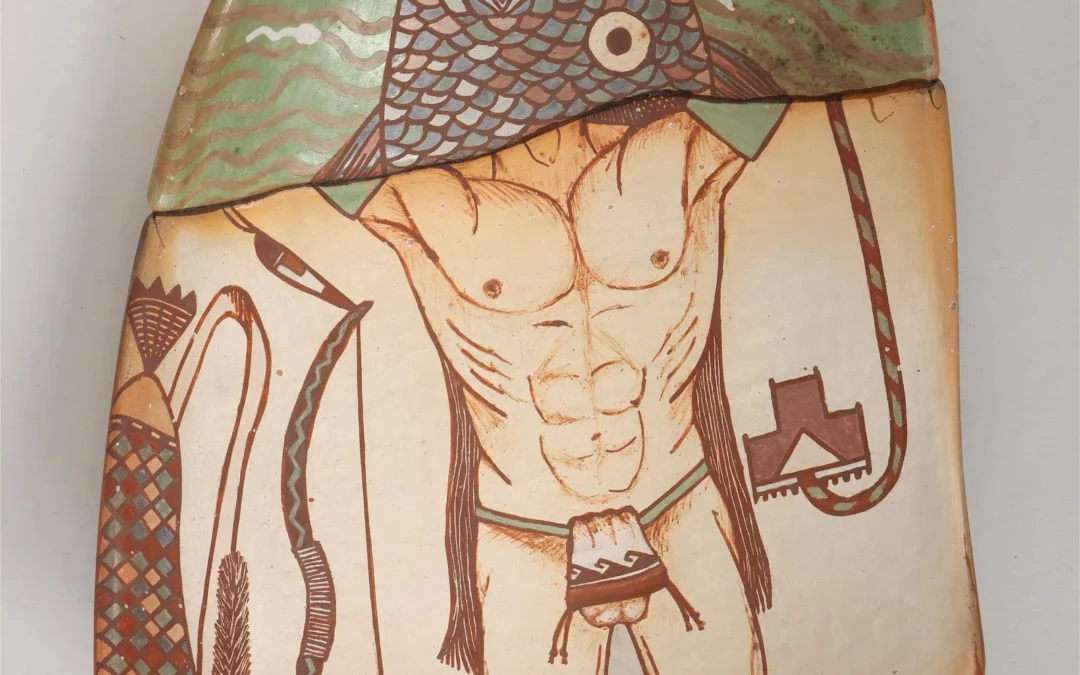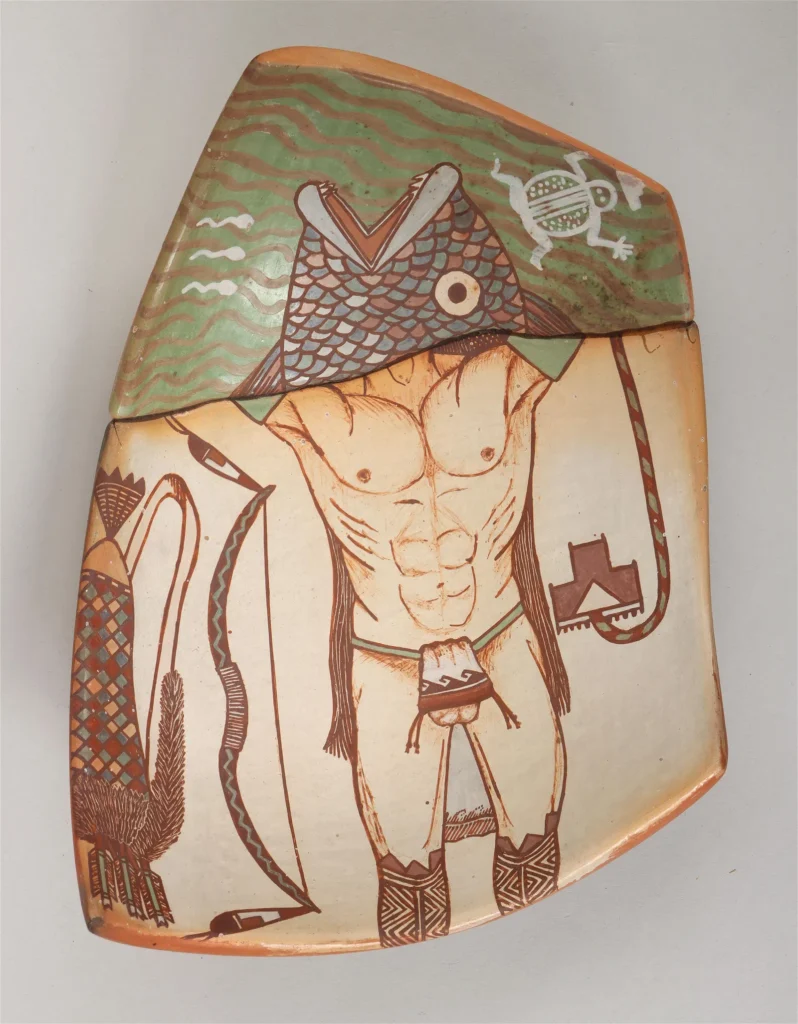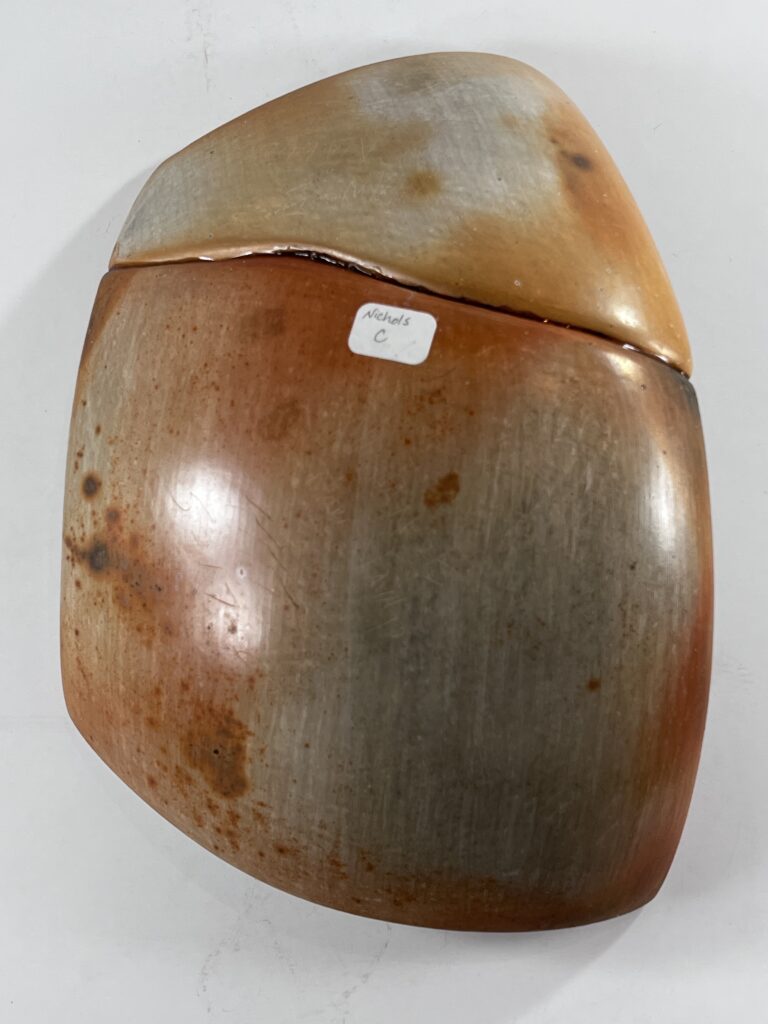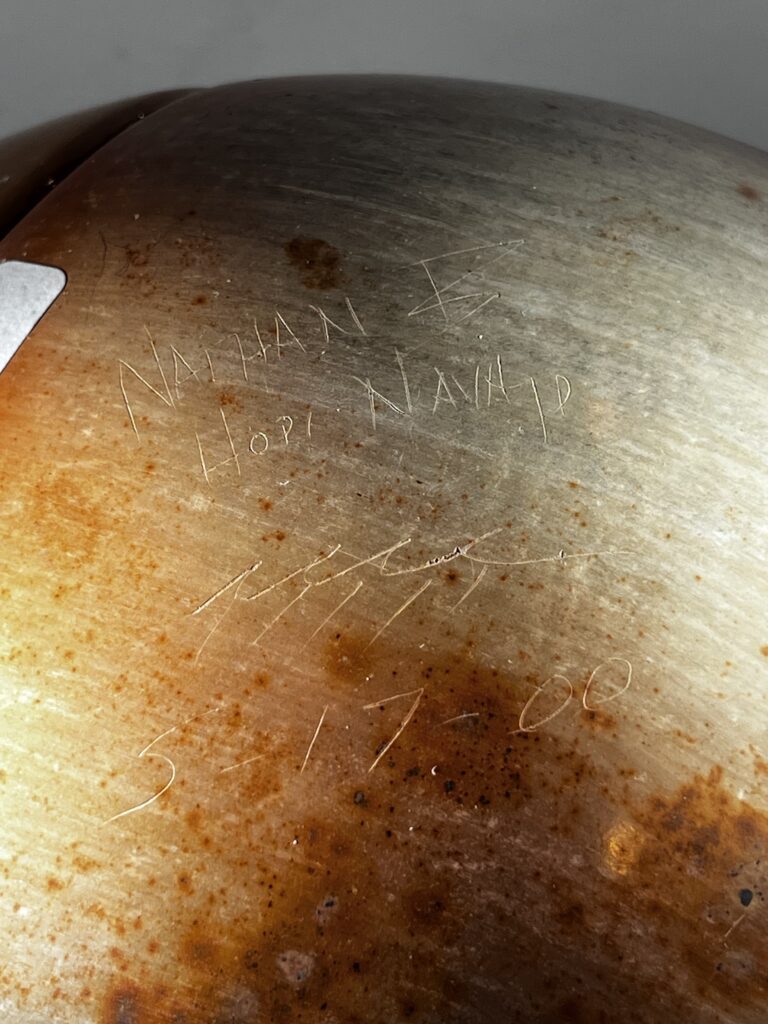The shards are 0.25” thick.
This is a two-shard pot displaying an arresting image of shapeshifting between a fish and a man, the direction of metamorphosis being unclear. Pueblo mythology describes shapeshifting, but I do not know if Nathan had specific narratives in mind when he created this pot or if we are simply looking at the product of his very fertile imagination.
The pot discussed here was part of a two-pot box-lot, the second pot also being two-shard and depicting a lizard’s body with a man’s head (2023-04). The collection already included a shard pot by Nathan (2013-10), but that pot is considerably smaller, incorporates 5 shards, and has an entirely geometric design. These three pots have the form of broken vessels, but in fact are intact as Nathan intended them.
Form:
The form of this two-shard pot is simple: the lower shard is about twice as big as the top shard. The pot has 4 sides. One vertical side is longer than the other with the difference in length accommodated by a short sloping upper edge. Rick Dillingham pioneered the technique of breaking bisque-fired pots into pieces, decorating them, refiring the pieces and then reassembling the shards into an intact pot. See the “Dedication” of this website for an example of such a Dillingham pot. In contrast, Nathan Begaye made this shard “pot” by carefully cutting a larger shard into two smaller pieces when the clay was wet. No breaking of clay seems to have been involved. The edge between the two shards wavers a bit and the two shards fit together perfectly.
The smaller shard has a blushed bottom surface that is typical of Hopi pots that are fired outdoors. The larger, lower, shard is fired light-tan with some darker golden color on its concave interior. The convex bottom of the shard is strikingly blushed with darker splotches indicating that the fire might have directly touched the pot during firing. Thus the two shards had a different firing experience and were likely fired separately or at least occupied different locations in the same fire.
Design:
Radically different designs grace the upper and lower shards. The upper shard is entirely aquatic; the lower shard entirely terrestrial.
Upper Shard:
This shard has a teal blue background cross cut by 17 casually-drawn wavy brown lines: waves in an ocean.
A large fearsome fish head occupies the center of the shard. The surface of the fish is covered in 5 shades of scales organized into about 16 columns of from 1 to 14 scales. White, pink and blue scales mark the lower surface of the fish head. Blue, green and brown scales characterize the surface around the eye. The eye is simply two concentric circles with the pupil solid black and the outer circle white. Large fins grow from the upper and lower sides of the head, but are cut off by the edge of the shard. These fins display 5 alternating strips of blue and pink color. The large open mouth is fearsome with thick pale-blue lips, a V-shaped blood-red interior, and rows of 3 or 4 sharp white teeth in each jaw.
To the left of the head are are three white tadpoles. To its right is a stylized white frog or toad. Just above the head of the toad is a fragment of a white stepped pyramid.
Lower Shard:
Central to the design of the lower shard is the torso of a muscular near-naked man shown from his truncated neck and arms down to the top of his boots. The torso is drawn with great detail using brown paint against the pale tan of the unpainted surface of the shard.
Only the lower section of the neck is seen with shading giving it some dimension, including a central U-shaped form perhaps representing his Adam’s apple. The raised arms are truncated but hairy underarms are indicated. Just before the arms reach the boundary between the shards, they suddenly turn blue, the background color of the upper shard.
The neck and the upper-pectorals are shaded with fine lines. The pectorals display sharply-defined nipples and lower edges. Abdominal muscles are starkly-rendered, including the tense muscles on either side of the abdominals. There is a glimpse of hair between the neck and the man’s left arm. This long hair spills out along both sides of his body from his midsection to his thighs.
A blue belt supports a small 0.75-inch-square loin cloth. In spite of its small size, the loin cloth is rendered in detail. Three creases mark its upper section, each casting a shadow. The lower edge of the loin cloth is composed of four thin parallel lines: black, tan, red and black.Toping this set of lines are three black triangles with squared crooks emerging from their right edge. From the points of the loin cloth emerge knotted strings, four in total indicating that the loin cloth is folded over the belt. The torso is sexually accurate. The loin cloth is so short that it leaves the lower half of the man’s scrotum exposed. A broad pubes is seen below the blue belt on either side of the loin cloth.
The upper thighs are bracketed by muscular creases. Knees remain invisible. Instead the lower legs are marked by the top of tall boots carrying a detailed zig-zag design biroificated by a single unpainted line. The top edges of the boots are marked by three horizontal and parallel lines (two-lane highways) surmounted by three brown triangles.
To the left of the torso (viewer’s perspective) are a bow and quiver drawn in great detail. The black bow is decorated with a wavy blue line. The grip is wrapped with 23 turns of a white cord. From the ends of the bow dangle pahos prayer feathers. To the left of the bow, partially cut off by the edge of the shard, is an elaborate quiver presented upside-down from a viewer’s perspective.
The quiver contains three arrows with black fletches and blue shafts. The open edge of the quiver appears to be lined with the pelt of an animal, perhaps representing the man’s clan. Its tail hangs down (up) parallel to the carrying strap of the quiver. The body of the quiver is decorated with a 7-row-by-13-column mosaic of blue, white and red diamonds, though some of the diamonds are truncated by the edge of the quiver. The bottom edge of the mosaic is marked by a black line carrying four white dashes. Following is a dome-shaped tan element that completes the body of the quiver. From its end dangle a fan of four feathers, their shaft displaying 7 parallel lines, their tips black triangles.
To the right of the torso (viewer’s perspective) is a ceremonial crook with alternating brown and blue markings. Like the quiver, the crook is also presented up-side down. From is handle “hangs” a mauve stepped pyramid incorporating an unpainted triangle. From the bottom edge of this pyramid blessed rain falls. Unlike the crook, the pyramid and rain are presented right-side-up so the rain falls down towards the bottom of the shard.
Both shards are lightly scratched marked on their bottom:
Nathan B
Hopi/Navajo
cloud cypher
5-17-00
the last line indicating the date of firing.
Design Analysis:
The most obvious character of this shard pot is the exceptional detail of its painting, though such fine work is not unusual for Nathan (cf 2017-06 and 2018-10). The shading of the male torso gives it a realistic and three-dimensional character. Notice how carefully the individual strands of hair of the hunter are drawn, with the same detail given to the hair of the pelt on the quiver. Pueblo textiles characteristically have tassels at their corners, so drawing such tassels on the breach cloth is not unusual. However Nathan did not simply draw a tassel at each corner of the garment, but drew 4, thus indicating that the cloth had been folded over the belt. Genius is in the detail.
While the subject matter of the two shards are radically different, their designs are linked by the similar pattern of interlocking forms (“ tessellation”) on the fish head and the quiver below. More subtly, the blue wavy line on the bow reflects the waves on the upper shard. Notice also that just as the raised arms of the torso approach the boundary line between the shards, they turn solid blue, the background color of the shard above. These commonalities serve to link the radically different designs on the physically-distinct shards.
The large, fiercely-toothed, mouth of the fish recalls the flesh-eating piranhas of the Amazon. The bow and quiver of the muscular man qualify him as either a hunter or warrior, or both. Thus both fish and man are dangerous to their enemies, establishing a theme across the two shards.
Note again that the accoutrement of items surrounding the torso are presented upside-down from an observer’s point of view. Thus the torso and its side elements of design have opposite orientations, further disorienting a viewer already thrown off balance by the fish/human metamorphosis. In this orientation the arrows ought to fall out of the quiver, but don’t. Contrarily the stepped pyramid on the handle of the crook is oriented correctly from a viewer’s perspective, with the rain fringe falling down, further contradicting other elements of the design around the torso. The accumulated effect of these contradictions adds tension and interest to pot 2023-03.
While Nathan was willing to depict nude males [cf 2015-02], nudity is not common in Native art; scrotums are rarely depicted. Nudity alone creates energy and interest in the design.
However like the contrasting colors of the shards, the image on each shad remains visually distinct. The human neck is not integrated into the fish head above. One simply stops and the other begins. As a result the resulting creature does not seem coherent or viable. It’s a walking fish head. Perhaps shard bowl 2023-02 is a snapshot of an ongoing metamorphosis and subsequent development of the creature might present a more holistic form. The form presented here is simply startling. Contrast this bifurcated image with the more integrated lizard man depicted on shard pot 2023-03.
If you are familiar with my discussion of warrior mask 2023-02, you will recognize that I can be fully-engaged with a pot by Nathan Begaye. My response to shard pot 2023-03 is more tempered. I find its metamorphosis and nudity a bit shocking, but not engaging. If Nathan intended to convey meaning, I don’t get it. You might have a different response.





